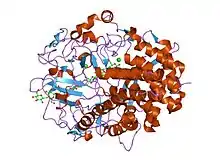| Glyco_hydro_48 | |||||||||
|---|---|---|---|---|---|---|---|---|---|
 x-tal structure of the mutant e44q of the cellulase cel48f in complex with a thiooligosaccharide | |||||||||
| Identifiers | |||||||||
| Symbol | Glyco_hydro_48 | ||||||||
| Pfam | PF02011 | ||||||||
| Pfam clan | CL0059 | ||||||||
| InterPro | IPR000556 | ||||||||
| SCOP2 | 1fce / SCOPe / SUPFAM | ||||||||
| CAZy | GH48 | ||||||||
| |||||||||
In molecular biology, glycoside hydrolase family 48 is a family of glycoside hydrolases.
Glycoside hydrolases EC 3.2.1. are a widespread group of enzymes that hydrolyse the glycosidic bond between two or more carbohydrates, or between a carbohydrate and a non-carbohydrate moiety. A classification system for glycoside hydrolases, based on sequence similarity, has led to the definition of >100 different families.[1][2][3] This classification is available on the CAZy web site,[4][5] and also discussed at CAZypedia, an online encyclopedia of carbohydrate active enzymes.[6][7]
Glycoside hydrolase family 48 CAZY GH_48 comprises enzymes with several known activities; endoglucanase (EC 3.2.1.4); cellobiohydrolase (EC 3.2.1.91).
An example of an enzyme containing a domain belonging to this family is one of the cellulases (celA) from the genome of the thermophilic anaerobic bacterium Caldocellum saccharolyticum. The celA gene product is a polypeptide of 1751 amino acids; this has a multidomain structure comprising two catalytic domains and two cellulose-binding domains, linked by Pro-Thr-rich regions. The N-terminal domain encodes an endoglucanase activity on carboxymethylcellulose, consistent with its similarity to several endo-1, 4-beta-D-glucanase sequences, and is a member of the glycoside hydrolase family 9. The C-terminal domain belongs to this family shows similarity to a cellulase from Clostridium thermocellum (CelS), which acts synergistically with a second component to hydrolyse crystalline cellulose.[8]
References
- ↑ Henrissat B, Callebaut I, Fabrega S, Lehn P, Mornon JP, Davies G (July 1995). "Conserved catalytic machinery and the prediction of a common fold for several families of glycosyl hydrolases". Proceedings of the National Academy of Sciences of the United States of America. 92 (15): 7090–4. Bibcode:1995PNAS...92.7090H. doi:10.1073/pnas.92.15.7090. PMC 41477. PMID 7624375.
- ↑ Davies G, Henrissat B (September 1995). "Structures and mechanisms of glycosyl hydrolases". Structure. 3 (9): 853–9. doi:10.1016/S0969-2126(01)00220-9. PMID 8535779.
- ↑ Henrissat B, Bairoch A (June 1996). "Updating the sequence-based classification of glycosyl hydrolases". The Biochemical Journal. 316 ( Pt 2) (Pt 2): 695–6. doi:10.1042/bj3160695. PMC 1217404. PMID 8687420.
- ↑ "Home". CAZy.org. Retrieved 2018-03-06.
- ↑ Lombard V, Golaconda Ramulu H, Drula E, Coutinho PM, Henrissat B (January 2014). "The carbohydrate-active enzymes database (CAZy) in 2013". Nucleic Acids Research. 42 (Database issue): D490-5. doi:10.1093/nar/gkt1178. PMC 3965031. PMID 24270786.
- ↑ "Glycoside Hydrolase Family 48". CAZypedia.org. Retrieved 2018-03-06.
- ↑ CAZypedia Consortium (December 2018). "Ten years of CAZypedia: a living encyclopedia of carbohydrate-active enzymes" (PDF). Glycobiology. 28 (1): 3–8. doi:10.1093/glycob/cwx089. hdl:21.11116/0000-0003-B7EB-6. PMID 29040563.
- ↑ Te'o VS, Saul DJ, Bergquist PL (1995). "celA, another gene coding for a multidomain cellulase from the extreme thermophile Caldocellum saccharolyticum". Applied Microbiology and Biotechnology. 43 (2): 291–6. doi:10.1007/BF00172827. PMID 7612247. S2CID 22500191.